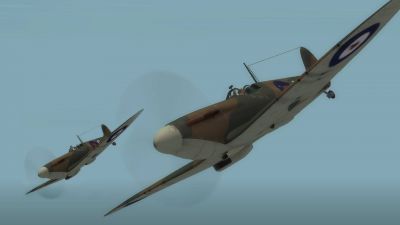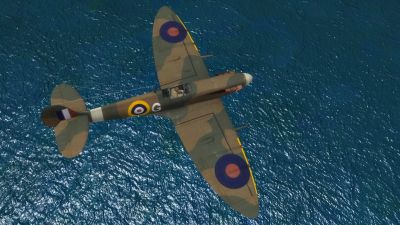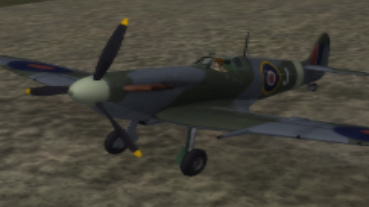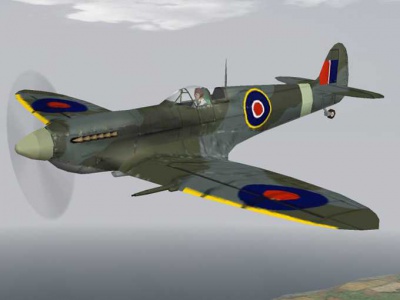Spitfire
Supermarine Spitfire Mk IA

| |
| Supermarine Spitfire Mk IA | |
| Specifications | |
| Type | Fighter |
| Armament | 8 x .303cal machine guns |
| Crew | 1 (Pilot) |
| Weight | 2,651kg |
| Top Speed | 565km/h |
| Armored Glass Windscreen | yes |
| Pilot Armor (back/head) | yes |
History
The Spitfire is probably the most famous fighter aircraft of all time, and arguably one of the most beautiful, with its unmistakable elliptical wings and sleek lines. The Spitfire was based on the Rolls Royce Goshawk-powered Supermarine Type 224, Vickers Supermarine designer Reginald "R.J." Mitchell’s ugly gull-winged entry into the 1934 British Air Ministry Specification F7/30 fighter competition. The 224 was a disappointment, but Mitchell persevered with development.
Mitchell decided to fit the new Rolls Royce PV12 engine (soon to be renamed the Merlin) and refined the design, introducing retractable landing gear and the familiar elliptical wings, which, ironically, was inspired by the German Heinkel He-70. The new Type 300 showed such promise that the Air Ministry drew up a specification for it (F37/34) and funded the prototype. The all-metal Type 300 was a stressed-skin, low-wing monoplane with a tail skid and a fixed-pitch, two-blade wooden propeller, and space for an unheard of 8 machine guns! Soon after its first flight, Mar. 5, 1936, the Air Ministry ordered 310 Spitfires. Mitchell, ill with cancer since 1933, died June 1937.
Vickers Supermarine immediately ran into problems. The small subsidiary only had experience building small quantities of flying boats and a few racing seaplanes - “Supermarine”, the opposite of “submarine”, means flying boat. Other companies signed on to build parts of the aircraft (around 80% of the construction), but the technology to build this advanced fighter was just too much for the unskilled labor that was available. Nine months after construction began, only a few pairs of wings and fuselages were complete and the Spitfire order was very nearly canceled. Furthermore, the eight machine guns froze at high altitudes. It took over a year to develop effective gun heating.
But the production problems were sorted out, and the first production Spitfire Mk I flew May 1938. It differed from the prototype in that it had a tail wheel, a stiffer wing, a bigger fuel tank, and increased flap travel.
By 1939, about 50 Spitfires had been delivered; the first squadron to equip was 19 Squadron at Duxford. The first Mk I Spitfires employed the Merlin II engine driving a two-blade, fixed-pitch propeller, and only four of the eight planned .303cal (7.7mm) Browning machine guns due to a shortage. Supermarine introduced improvements during production: the bulged canopy (starting with aircraft number eight); a two-position, three-bladed propeller (no. 74); and the Merlin III engine with a Rotol or de Havilland three-bladed, constant-speed propeller (no. 194). Armor protection improved in stages.
When Britain declared war on Germany and sent forces to France, it considered the Spitfire too valuable to risk and retained the planes in Britain. Spitfires started flying sorties from southern England May 12, and were committed in large numbers as the fighting moved closer to the English Channel. Spitfires shot down about 260 aircraft during the Dunkirk evacuation at a cost of 72 losses.
The Mk IB introduced two wing-mounted Hispano 20mm cannon, each fed by a 60-round drum. Initially, wing flexing often jammed the cannons and four Browning machine guns were later added as a supplement. Only a few Mk IBs were built. The machine-gun-armed Spitfire was retroactively renamed the Mk IA.
The Spitfire offered performance similar to that of the superb Bf 109E, almost exactly equal to the Bf109E series below 15,000 ft (4,500 m), and slightly slower above. The 109 outclimbed the Spitfire, but the Spitfire held the edge in a turning fight. The 109 and its fuel-injected engine could perform negative-G nose-overs that the Spitfire could not follow because its carburetor-aspirated Merlin cut out during negative-G manoeuvres. The early Spitfire suffered somewhat from the low caliber of its weapons.
These weak spots were all that held back early versions of the Spitfire, but as it gained power and bigger guns, it truly fulfilled its design goals in staying fast, climbing quickly, turning tightly, and finally bringing decent firepower to bear on its opponents. It was the dogfighter's dream, not just in the beginning of the war but throughout.
Game Play
The Spitfire starts as the premier fighter aircraft for the Allied forces in the early days of a Battleground Europe campaign, and stays one throughout as it develops from the nimble but lightly armed Mk I through later versions like the Mk V and the Mk IX, both with 20mm cannons, more ammunition, and more powerful engines.
In the early days of a campaign, while the Bf 109E can out climb a Spitfire in a vertical drag race, the Spit has a noticeable turn rate advantage. The Spitfire Mk I does have a problem with aileron reversal at high speeds in dives, and good 109 pilots will force this upon you if they get into trouble. Negative G forces also evoke carburetor fuel starvation so be careful when pushing forward on the stick.
You can decrease the effects of this if you learn to use your rudder when diving after an enemy 109 trying to get away, and as long as you remember that rolling left stick will cause you to roll right (and vice versa) until you slow down some, you should be OK. If nothing else it will teach you to be a more intuitive pilot although it might be frustrating at first.
Remember to save your ammunition as you don’t have a lot of it, and work to get in very close before firing as the light machine guns of both the early Spitfire and Hurricane fighters do not work well at long range. Hits at longer ranges will only waste ammunition for little or no reward. Aces in these planes can get multiple kill sorties but only because they hold their fire until they are almost eating the rudders of their opponents and they set their gun convergence short, where it will multiply the effects of the guns close to their targets.
Set convergence of your guns with “.conv<space><convergence range number in meters> “ when in the game.
Supermarine Spitfire Mk IIB
History
The British military establishment realized the need for more armament on its warplanes, but failed to understand that rifle caliber machineguns where no longer effective, no matter how many where installed. The RAF scrambled to up arm its fighters with cannons, and the IB was the RAF's first cannon armed fighter.
That Ib varient suffered numerous serious failures with its hasty cannon installations so few where built (about 300). Close on its heals however came the IIb that fixed these problems and had a side benefit of a slightly more powerful engine as well.
Game Play
Use basically the same combat tactics and methods you used in the Spit Ia, because the greater weight of the Mk.IIb over the Mk.Ia cancels out most of the gain from the more powerful engine. You do have a very slight increase in climb and top speed, but it's a very, very small increase ... effectively you're flying almost the same aircraft except you have the 2 x 20mm Hispano cannons which are one of the best air to air 20mm aircraft cannons developed during WWII.
Supermarine Spitfire Mk VB
History
The Mk V variant Spitfire had several combat improvements over earlier models, such as bigger guns, more protective armor, and better all-round flight performance. A big plus was the ability to perform negative-G maneuvers in combat while retaining full engine power. While most noted for its combat record over the deserts of North Africa, the Mk VB saw action in almost every theater of war and formed the basis for the Royal Navy's only carrier-based version, the Seafire. Equipped with 20mm cannons in place of half the earlier marks rifle-caliber machine guns, this model of Spitfire was the first really numerous type to hit hard enough quickly enough to really hurt an enemy aircraft in the increasingly short firing solutions that modern air combat was moving towards ... with increasing emphasis on speed over turn rate. It was still the premier turn-fighter in Royal Air Force service in the European theatre and one of the best of WWII.
Game Play
As the Spitfire evolved, it became a more potent fighter. Its adversaries were forced to keep pace by developing new designs and putting resources into the evolution of existing airframes. If the Axis ignores the threat of Spitfire air superiority in favor of tanks, its advanced tanks will succumb to bombs as the Allies tend to grab air superiority if ignored in the aerial arena. The impact of the high quality Mk V and Mk IX Spitfire designs is not restricted to better guns and airwar performance, but is felt in other aspects of the war where the campaign can be won or lost.
Players choosing the Spitfire V can rely on having one of the best turn-rate/speed fighter combinations in Battleground Europe. The Bf 109F will still outclimb you but you will finally have the measure of the earlier Bf 109E. You can beat the E model in speed (but not the F model) as well as in turning, and you have firepower equal to the E and almost the equal of the F. You can shoot more 20mm rounds for a given trigger time (you have two cannons while the 109F has but one) but the 109F will be able to shoot its larger 20mm ammunition capacity over a longer duration. Overall, in a pure dogfight of one versus one, most average pilots would be more at home in the Spitfire than the 109. The 109 has advantages that good pilots will always press home, but never consider good 109 pilots to be “average” pilots. You would be wise to remember this whether you are in a Spitfire V or IX.
Supermarine Spitfire Mk IXC
History
The Mk IXC model Spitfire was the RAF's next move up the performance curve for the Spitfire series of fighter aircraft. Climb rate, top speed, and ammo load out were all improved markedly over the Mk VB, producing a faster, quicker climbing Spitfire with twice the 20mm cannon rounds. The even later E wing variant replaced the two .303cal light machine guns in each wing with a .50caliber heavy machine gun, increasing its hitting power to take advantage of the more limited firing solutions present at higher speeds.
Even when later versions were deployed in conflict, the IX model still enjoyed more combat success than its successor Spitfire variants. Its combination of climb, speed, and turn rate had produced almost an ideal configuration and it continued to serve in large numbers. As the war moved east into Germany the Spitfire's last weakness was finally exposed. It lacked the fuel capacity to penetrate deeply enough into German airspace to do combat and return home to Allied airbases still a long way from the eastern reaches of the German homeland.
Game Play
While the Spitfire VB is favored at times by some because it retains an extremely tight turning ability, the Mk IX is really the pinnacle of the line even if it doesn’t turn quite so tight as its older sister. It can still turn tighter than anything else that can go as fast and it enjoys a climb rate unmatched by any other plane in the game. Even the vaunted Bf 109F needs to watch out after the Allied RDP factories introduce the Spitfire Mk IX to a Battleground Europe campaign, since this Spitfire bests it in both speed and climb, the precise advantages it holds before the IX makes its debut.
Packing 120 rounds per gun for each Hispano 20mm cannon (twice the loadout of the Mk V) and having speed and climb rate second to none in the game, the Spitfire Mk IX is the epitome of the air-superiority fighter. It does, however, have a few foibles that may bother the unwary combat pilot, not the least of which is the ability to black out its pilot relatively easily as it carries a lot of speed and engine power into what is still a very tight turning circle. Remember to slow down before committing to a maximum rate turn. This actually applies to any aircraft capable of speeds of 650 km/h or more but because the Spitfire's low-drag elliptical wings retain energy so well, it may seem pronounced to a higher degree while flying this aircraft in combat. The Spitfire's traditional light elevator further complicates the matter.
While the wing twist that causes aileron reversal in the earliest versions of the Spitfire is much reduced in this later version, the high speeds to which the Merlin 66 engine could push the sleek airframe may still produce this undesirable effect. Be careful rolling the aircraft while traveling at the extremely high speeds gained in dives from higher altitudes while in pursuit of enemy aircraft.
| Air Units in Battleground Europe | |
|---|---|
| Fighters and fighter bombers | |
| Bf 109E-1 | Bf 109E-4| Bf 109E-4B |Bf 109F-2 | Bf 109F-4 | Bf 109G-2/R1| Bf 109G-6/U4 | Bf 110C-4 | Bf 110C-4/B | Blenheim IF | Dewoitine D.520 | Fw 190A-3B | Fw 190A-4 | Hawk 75 | Hawk 81 | Hawk 87 | P-40F Kittyhawk Fighter Bomber | | Hurricane Mk I | Hurricane Mk IIb | Hurricane Mk IIc | Hurricane Mk IID | Junkers 87G2 'Stuka' | P-38 'Lightning' | Bell Model 14a / P-400 Airacobra | Model 26 / P-39N Airacobra | Spitfire Mk Ia | Spitfire Mk IIb | Spitfire Mk Vb | Spitfire Mk IXc | |
| Bombers | |
| Blenheim IV | Douglas DB-7 | Havoc Mk.I | A20C Havoc | Heinkel 111 | Junkers Ju 88A4 | Junkers 87 'Stuka' | | |
| Transport | |
| C47 'Skytrain' | Junkers 52 | |


